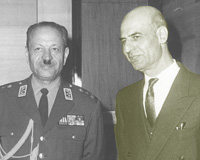Son of Mohsen Sadrolashraf, Seyyed Javad Sadr was born in Tehran, 1912. He received his primary and secondary education in Ettehadieh, Elmieh, Adab, Aqdassieh and Darolfonun schools of Tehran. He graduated from the university of Tehran in law degree. Then, he left for France to continue his education in 1925...
Son of Mohsen Sadrolashraf, Seyyed Javad Sadr was born in Tehran, 1912. He received his primary and secondary education in Ettehadieh, Elmieh, Adab, Aqdassieh and Darolfonun schools of Tehran. He graduated from the university of Tehran in law degree. Then, he left for France to continue his education in 1925, and he received his doctorate in 1929.
Upon his return to Iran, he went to the ministry of interior. After two years, he was employed in the ministry of foreign affairs. From 1945 to 1947, he was the first secretary of Iran’s general consulate in Palestine. When Abdolhossein Hazhir formed his cabinet in 1948, he was appointed the head of the prime minister’s bureau. He held the office during Saed and Mansurolmolk terms and some period of Razmara’s cabinet. He became the chief of ministerial bureau of the ministry of foreign affairs. After a short while he became the director general of ministry of interior’s joint stock company. In the 17th term of Majlis elections, he rivaled with Shahaboddin Khosrovani from Mahallat and Kamareh. However, his rival won the seat and entered Majlis.
He held various offices until 1963 including membership in Iranian mission to the general assembly of united nations, charge d affair to Iranian embassy in Belgrade, and Iranian ambassador to Japan.
His real activity in political scene began when Mansur founded the progressive center which was affiliated to the United States, 1960. When Mansur formed his cabinet, most of his ministers were the members of the center. Sadr was appointed as the minister of interior and deputy prime minister. In 1963, he was commissioned by Mansur to put an end to Imam Khomeini’s exile in Qeitarieh of Tehran. He met the Imam and announced him that he is free to leave for any part of the country. The arrest and trial of Fars tribe chiefs and the suppression of the riot, performing the second phase of land reform in Tehran, ratification of capitulation law for the U. S. military forces, the exile of Imam Khomeini to Turkey, increase in oil and petrol prices which led to the strike of drivers and ended in the suppression of them by government forces, were among the events happened during his office as the minister of the interior.
He carried great structural changes in the ministry of interior. Divided the ministry into five sections. Upon Mansur’s assassination and coming of Amir Abbass Hoveida, he was the minister of interior for a time. In Hoveida’s next cabinet, he was appointed minister of justice.
Following his membership in the Progressive Center, he joined Iran Novin party. He was a freemason and a member of Forughi Lodge. He was imprisoned two times after the Islamic revolution. After his release, he died due to cancer in Tehran, 1990.
https://iichs.ir/vdcj.mevfuqemt29zu.html
iichs.ir/vdcj.mevfuqemt29zu.html
